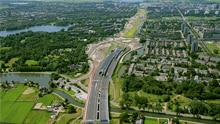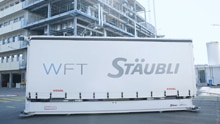Smart City – the intelligent city of the future: The aim is to make our cities more efficient, more environmentally friendly, and more advanced. An important component of this is autonomous vehicles, which can for example independently transport passengers. SICK, as a partner of Siemens, contributed its safety expertise to a pilot project in Hamburg HafenCity. The challenge: To use sensors in the infrastructure to detect persons and objects in complex urban situations in order to assist autonomous buses on their route through the city using the captured data.
Safety expertise for implementing innovative Smart City projects
Over a period of several months, millions of measurement data were analyzed and evaluated. The setup: In Hamburg HafenCity in late 2021, numerous partners tested the future of autonomous public transportation. An autonomous electric bus navigated between a total of five stops along an 1.8 kilometer (1.1 miles) stretch and transported passengers through Hamburg’s world famous suburb – in a trial operation with a backup driver. The bus was supported along its route through the complex urban environment by infrastructure sensors that provided the autonomous bus with additional data about its surroundings in particularly difficult to navigate areas. The objective: to improve the performance and, in particular, the safety both of the passengers and the other road users. At one particular intersection with poor visibility, LiDAR sensors from SICK were also trialled in a collaboration between Siemens and SICK.
The bus was out and about for several months during the pilot project. Enough time to capture comprehensive measurement data using the sensors at the street intersections.
Extensive evaluation of measurement data
Several sensor systems were employed at the same time in the test field. This enabled the data from the different systems to be directly compared in order to systematically investigate their strengths and weaknesses. A particular challenge in this was how to handle the enormous quantities of data. A cloud-based analysis software specially developed by SICK allows the automatic identification of critical deviations and a systematic investigation of safety-relevant situations.
At the conclusion of the project it was clear: This data-driven approach is capable of providing reliable insights into the performance and the safety-related characteristics of the sensor systems even in this difficult to navigate inner city scenario. The results of the joint study were then used to validate the overall system and were presented in a plenary session of the safe.tech conference in Munich in a joint contribution by Siemens and SICK.
Rolf Schmid, Senior Expert Validation at Siemens remarks: “SICK's experience and expertise in the area of rugged and reliable detection and data collection by sensors was essential to achieving the project objectives.” Schmid emphasizes in particular the collaboration of the two companies and adds: “When it comes to data collection, data evaluation, data plausibility, and data validation, SICK was exactly the right partner for this project.”
Magnus Albert, Senior Expert Safety Methods at SICK AG, summarizes the project as follows: “Only through the automated evaluation of large quantities of field data were we able to draw conclusions on the reliability and availability of our system in an urban environment. This was made possible by the trusting partnership with Siemens at the real-life intersections. That was pivotal in our ability to use these totally novel data-driven approaches for verification purposes, and to show that the system is already very reliable.”
Making the smart city safe
As part of the Smart City initiatives, more and more cities are now striving to increase their safety, efficiency and sustainability, and consequently the quality of life of their citizens, using new technologies and through increasing digitization. This is the only way for cities to remain competitive and future-ready.
Smart City initiatives affect lots of different aspects of our lives, such as buildings, supply and disposal of goods and data, mobility, service provision, health care, water or energy supply. The area of mobility permeates most areas of a Smart City and is almost always a necessary prerequisite for the smooth operation of a city of the future. The expansion of infrastructure and traffic services right through to “smart mobility” is therefore a key objective. Smart mobility is also expected to make a decisive contribution to the so-called “Vision Zero”, which is the goal to achieve zero traffic-related fatalities. Especially because a large proportion of the road causalities in cities involve pedestrians and cyclists, i.e. VRUs (Vulnerable Road Users).
Using highly automated and autonomous vehicles in our local public transport systems is essential for achieving these goals. These vehicles can be operated much more safely, can avoid accidents, and can maintain the traffic flow. To operate them safely, though, requires specific information that can only be determined using data from sensors in the infrastructure.
These data must also be available, reliable and meaningful at all times. It is in precisely this area that the aforementioned expertise of SICK can make a fundamental contribution and facilitate these solutions. Together with Siemens, SICK Smart Mobility has substantially progressed the realization of these goals, thereby enabling Smart Cities to design their traffic systems to be even safer and more sustainable.







